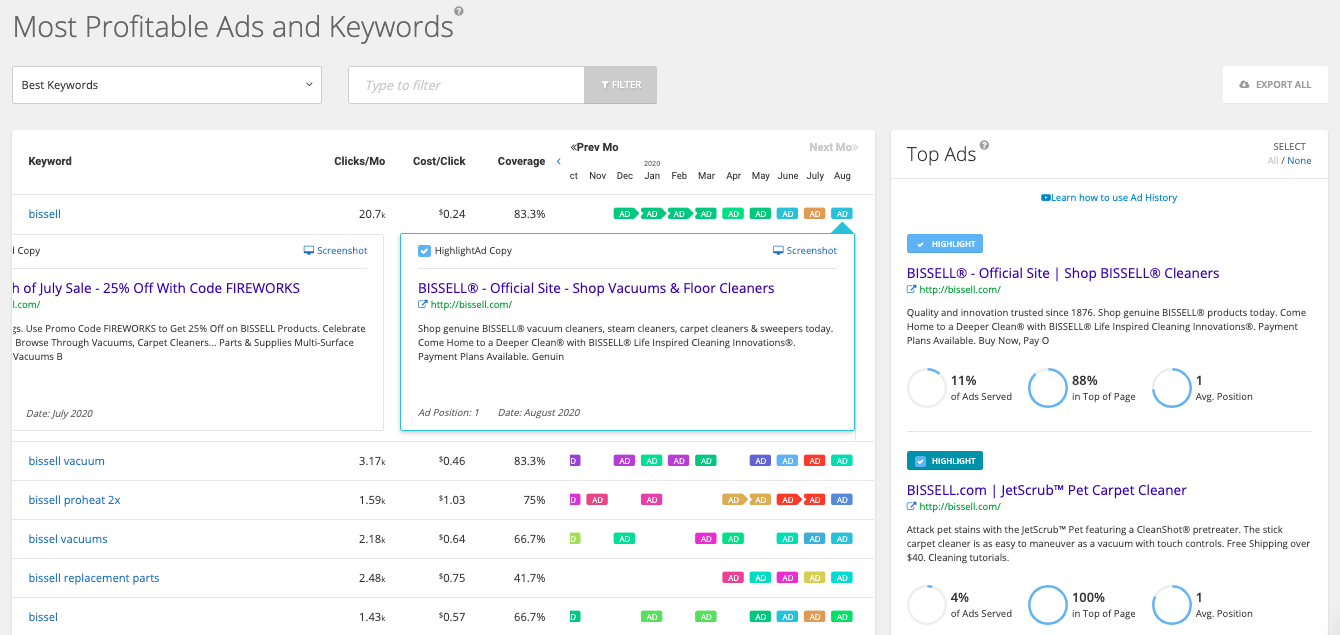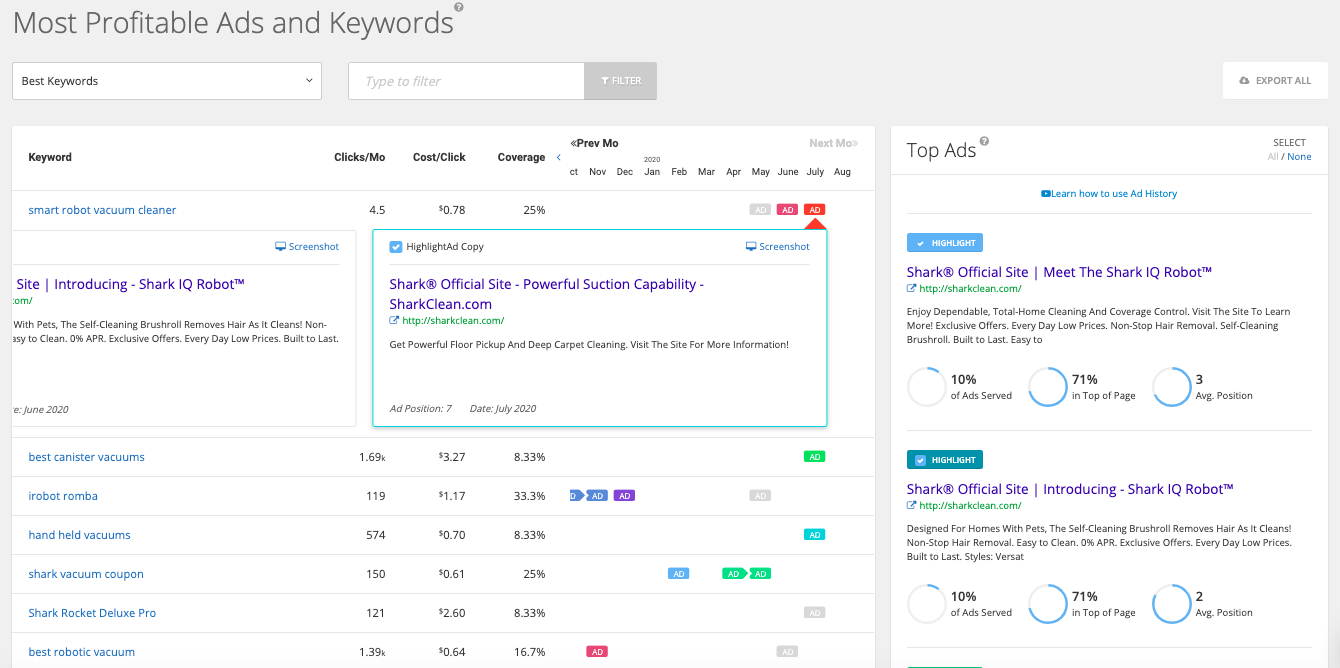Creating a realistic budget for your advertising campaigns is important. If you’re not accurately accounting for the costs, it’s easy to miss the mark. But when someone asks how much do Google Ads cost? There isn’t really a good answer. One thing is clear though—when you overspend on your Google Ads budget, you’re not just wasting money, you’re also putting your brand in front of customers who will never convert.
Whether you’re building an advertising budget for the first time or setting up for your next campaign, the more insight you have into your competitors’ ad spend, the easier it will be to define your own ad spend. That’s why we wanted to take a look at the data and see if we could provide a definitive answer.
We ran an analysis of 48 advertisers to find best practices for Google Ads budgets.
Understanding how to create a great Google Ads budget isn’t just about saving money—it’s the way you refine your target audiences and the cost to acquire, engage, and convert them. The right costs for your competitors won’t always be the best cost for you. A great advertising strategy is all about finding the most relevant, valuable keywords for your audience.
In this article, we’ll talk through how you can use SpyFu’s competitor analysis tools to gather Google Ads data on your competition and, using some simple math, approximate their overall spend. Let’s dive in!
The Methods
To answer the question how much do Google Ads cost, we first needed to put together a list of industries to dig into. The idea here was to sample enough variety that our data would appeal to a wide audience, without focusing too much on any given industry.
We chose these industries based on feedback to our Support and Google Ads teams as well as conversion-rate optimization data.
We wanted to avoid locally driven industries like plumbing or construction, as local-focused businesses tend to serve unreliable spending data. This is due to the nature of local spending in Google Ads and the hyper-targeted types of ads that make sense in these industries.
From there, we put together a list of predominant advertisers across 16 different industries, each defined by a core topic keyword:
| * Alaskan fishing trip | * Knitting kits |
| * Animal rescue/welfare | * Mattress |
| * Auto insurance | * Storage and moving |
| * Auto tint | * Podcasts |
| * Beekeeping | * Roof racks (automotive) |
| * Women's apparel/boutique | * Screen printing |
| * Groomsmen gifts | * Teeth whitening |
| * Jobs/recruiting | * Vacuum cleaners |
Next, we chose the top three advertisers in each industry based on the Top Ad Competitors report.

With the industries and domains defined, we returned to the industry topic and looked at the "Also buys ads for" report. This let us to narrow down to the top 10 related keywords (by monthly search volume) for each topic:

Next we selected all 10 keywords and exported them to a spreadsheet using the Export Selected option.

This export provides us with a lot of valuable information, but for the purposes of this analysis, we chose the following three columns to build our calculations:
- Total Monthly Clicks: The total amount of monthly clicks for each keyword
- Percent Paid Clicks: The percentage of those total monthly clicks that were made on paid ads
- Phrase Cost Per Click: The cost-per-click on each keyword
We used phrase cost-per-click (CPC) because we wanted to be as accurate as possible with the keywords we chose. There was no need to include the kind of semantic variation that occurs for broad match keywords. The goal was to get as close as possible our target audiences’ search intent.

Disclaimer: You’ll see that the Percent Paid Clicks is not showing for beekeeper equipment in the above screenshot. That’s due to a lack of available SERP click data for that lower volume keyword.
We used these three columns to calculate the total Google Ads cost using the following formula:
Total Monthly Clicks x % Paid Clicks x Phrase Cost Per Click
If we wanted to calculate the estimated cost for beekeeping supplies, for example, the formula would look like this:
8,300 (clicks) x 38.3% (% paid clicks) x $1.45 (phrase CPC)= $4609.45
Repeating that with the nine other keywords in our top 10 gave us the Top 10 Keywords - Monthly Cost. To make sure we didn’t skew these results too much, we also filtered out any branded keywords from the top 10 results.
So, now that we know how we calculated these estimated ad costs, let’s take a look at the results.
A Breakdown of Google Ads Cost by Industry and Advertiser
Taking a look at the numbers, it’s easy to see there are some significant budget differences between industries as well as individual advertisers within those industries.
















Keep in mind that high spending at the domain level must also account for the advertiser's overall Google Ads budget. While dyson.com and bissell.com focus on vacuum cleaners, they have other products in their lineup. Geico.com and Progressive.com offer other services beyond automotive insurance. That's why we are looking at the keyword level as well as the domain level.
How to Build Better Budgets by Understanding Competitors’ Ad Spend
Breaking down advertising costs by keyword and top competitors helps you gain insight into the potential cost of running ads within a given industry. You will notice that there was not one dominant pattern in the examples we gave.
There are three key takeaways after taking a look at the data:
- Budgets vary from industry to industry based on the overall competitiveness of target PPC keywords.
- The more competitive the industry, the more likely it is for companies to overspend on the top 10 keyword costs.
- Most advertisers spend less than the overall monthly cost for the most competitive keywords.
So, what does this mean? Let’s break down each takeaway individually.
Use Industry Budgets to Guide Further Research
Understanding how much Google Ads cost for your industry requires a lot of insight into your specific market. When you’re getting started with a new advertising campaign, it’s important to look at the major players in your market, as well as the overall cost of going after the top 10 PPC keywords.
With this knowledge, it’s easier to build a realistic budget for your overall advertising strategy that makes a positive impact on your business goals. It gives you a way to maximize every dollar you spend.
Let’s take a look at the breakdown for the auto tint industry:
- Top 10 keywords: $10,903
- PrecutAutoTint: $6,620
- WindowTint: $9,230
- Window Tint Supplies: $2,460
The overall cost to advertise across all top 10 keywords is just over $10K, but only WindowTint is close to that budget. This signals that they’re probably going after more competitive keywords, which is increasing the overall cost of their ads.
PrecutAutoTint and Window Tint Supplies, on the other hand, both underspend—meaning they’re either established in the market or don’t have the time or money to allocate to PPC advertising. While understanding their budget won’t tell you exactly which strategy they’re using, it gives you a jumping-off point to do a bit more analysis.
In this case, we would suggest taking a look at their Ad History, content marketing strategy, and top keywords to get a better sense of where their focus lies.
Use Overspending on the Top 10 Keywords as an Indicator of Brand Strategy
When one of your competitors overspends on the top 10 keyword costs, that’s definitely something you need to pay attention to. It can help you understand the landscape of your market a bit better by highlighting where certain competitors position their brand.
Just take a look at the variance between advertisers for the vacuum cleaners industry:
- Top 10 keywords: $37,856
- Dyson: $84,000
- Bissell: $22,600
- Shark: $28,600
Dyson, Bissell, and Shark are all well-established in the market today, each with their own brand presence and loyal customer base. So, why would Dyson be spending more than double the top 10 keyword costs? There are a few potential reasons for that:
- They’ve seen a great return on ad spend (ROAS) from their Google Ads.
- They’re trying to entice customers away from competitors.
- They’re going after a larger set of target PPC keywords.
Based on cursory research of their company, it’s likely a combination of all three. While we can’t know what their ROAS actually is, Dyson is definitely one of the leading vacuum brands to make a sincere push in online marketing. Also, they offer products outside of vacuums, including fans, hair care products, and lighting. When you combine this with their overall branding as a luxury item, it drives up the cost of their ads considerably.
Contrast this with Bissell, a company that’s been going strong since 1876. They have a well-established brand and focus their product strategy solely on vacuums and floor cleaning products. This makes their audience more targeted and engaged, so Bissell won’t have to do as much work to convince people of their value. They have over 150 years of history to fortify their brand.
We see a similar focus when looking at the types of keywords they target.
Keep Monthly Costs Low by Refining Your Target Keywords
Many advertisers spend less than the overall monthly cost for competitive keywords. When you’re building out an advertising budget, that kind of refined targeting ensures you’re getting the most out of every dollar you spend. The more competitive the keywords you target, the higher the costs, and the less of an impact you’ll make for each ad.
Bissell, for example, really doubles down on their branded keywords. When we take a look at the Ad History report in SpyFu, most of their best keywords include the brand name.

Focusing on these keywords helps them keep their position at the top of the SERP whenever anyone searches for their brand and also reinforces the strength of their brand.
Both Dyson and Shark bid on their branded keywords as well, but when we look at Shark’s target keywords, we also see a lot more non-branded keywords seeping in.

Going after keywords like best canister vacuum and best robot vacuum keeps Shark in the conversation for less specific searches as well. As they’re probably the smallest competitor in the bunch, that makes sense. Bidding on relevant keywords in their market helps them gain visibility across more different types of searches.
Ask How Much Do Google Ads Cost to Refine Your Strategy
Digging into the individual costs for target keywords in your industry is a great way to prospect how much your ad spend will impact SERP results. When you can see how much your competitors spend, it’s easier to estimate how much their strategy will drive up your overall costs. If you’re interested in learning more about running Google Ads campaigns, check out this article for more information.

